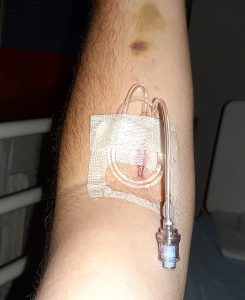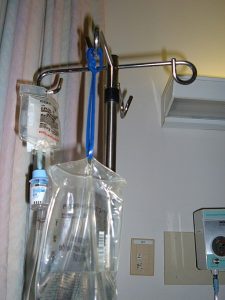7.4 Intravenous (IV) Medications and Solutions
Intravenous (IV) Solutions
It is relatively commonplace for patients to receive intravenous (IV) infusions when they are in hospital. There are various reasons why a patient may receive IV infusions:
- To replace lost fluids: Fluids may need to be replaced because the patient has lost blood or is dehydrated.
- To administer medication: When patients receive medication via the IV route, that medication is combined with an IV solution and usually run as a piggyback to the main line. This is discussed in more detail below, where different types of IVs are explained.
- To maintain electrolyte balance: Electrolytes such as potassium (K), for example, can be given via IV if the patient has low levels of a specific, or all, electrolytes.
- Potential to become depleted: An IV can be run at a low rate to avoid potential loss of fluids or electrolytes if they are likely to become depleted.
- Emergency situations: Emergency situations can occur during surgery or in the emergency department. In these situations, a patient may require various IV medications and fluid replacement.
- To administer blood and blood products: When blood or blood products are administered via an IV line, the line is always run secondary to an IV line of fluid in case the patient has a reaction to the blood product being administered.
There are different ways that IV fluids or medications can be given, and most of the subtypes of IV administration are listed below. All involve some form of IV access, which is usually through a small catheter placed into a patient’s vein.
- Primary infusion: This type of IV administration involves a bag of IV fluid being attached to a primary IV line, which is attached to a small catheter in the patient’s vein. It can involve the IV line being attached to a machine or simply use gravity and is measured by drip rates.
- Piggyback: In this method, a smaller secondary bag and line is attached to the primary infusion. This is shown in Figure 7.10 below, where you can see the smaller bag hanging from the pole. Typically, medication is added to the secondary bag as a way of slowly administering the medication to the patient.
- Saline lock: In this method, shown in Figure 7.11, a small IV line is attached to the catheter inside the patient’s vein and “locked” with a saline solution. There is a port on the end where a primary infusion line can be attached if IV fluids are needed. Saline locks allow patients to be mobilized more easily because they can be detached from the longer IV line and pole. Medication can also be given through the saline lock.

Fig. 7.11 
Fig. 7.10 - Direct IV: In this method, shown in Figure 7.12, medication in a syringe is attached to a port on the IV line and pushed into the line so the patient receives the medication at a faster rate than they would with a piggyback.
- IV bolus: A bolus is a large amount of fluid administered in a very short time. It can also be used as a way of administering IV fluids quickly in an emergency situation.

There are various IV solutions that can be used for intravenous infusions, and many of them are used regularly in a hospital setting. The more common types are listed below, but there are others that may be used on specialty units within the hospital:
- Normal saline 0.9%: This is one of the most commonly used IV solutions and is a mixture of sodium chloride and water. It has many uses in the hospital, the most common being fluid replacement. The abbreviation for this solution is NS.
- Normal saline 0.45%: This is a less common form of normal saline but can be considered 1/2 normal saline because the percentage of sodium chloride is half what it would be normally.
- 2/3 dextrose and 1/3 normal saline: This solution is a mixture of dextrose (sugar) and normal saline. The common abbreviation is 2/3-1/3.
- 5% dextrose in water: This solution is a mixture of dextrose (sugar) and water. The percentage indicated can vary depending on the level of dextrose in the solution; for example, it could be 10% or 50%. The abbreviation is D5W and again may vary depending on the level of dextrose; for example, 10% dextrose in water would be D10W.
- 5% dextrose in saline: This solution is similar to D5W but is a mixture of dextrose (sugar) and saline instead of water. The level of dextrose can vary, similar to the dextrose and water solution. The abbreviation is D5NS and can also vary depending on the level of dextrose.
- Ringer’s lactate: This solution is commonly used for fluid replacement and contains water, sodium chloride, sodium lactate, potassium chloride, and calcium chloride. The abbreviation is R/L.
Intravenous solutions come in a variety of sizes of bags, and the intended use usually determines the size selected. Primary infusions, for example, often use a larger size, whereas piggybacks use smaller solution bags. Some available sizes include the following:
- 1000 cc (1 litre)
- 500 cc
- 250 cc
- 100 cc
- 50 cc
- 25 cc
Review Exercises
Attribution
Unless otherwise indicated, material on this page has been adapted from the following resource:
Doyle, G. R., & McCutcheon, J. A. (2020). Clinical procedures for safer patient care. BCcampus Open Education. https://opentextbc.ca/clinicalskills/ licensed under CC BY 4.0.
Image Credits (images are listed in order of appearance)
IV pole top portion by BrokenSphere, CC BY-SA 3.0
Cannula B by 26RIJNA2020, CC0 1.0
ICU IV 1 by Calleamanecer, CC BY-SA 3.0

